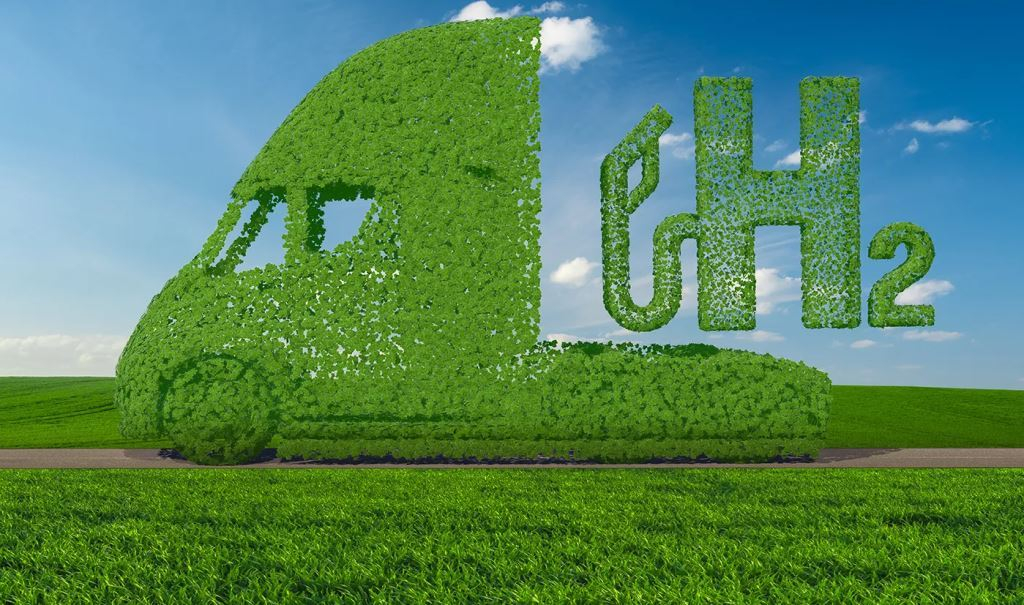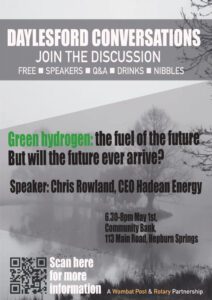Chris Rowland
Chris Rowland will be the guest speaker at the next in the Daylesford Conversations series hosted by Daylesford Rotary and The Wombat Post on Thursday, May 1, at 6:30 pm at 113 Main Rd, Hepburn.
In the early 2020s, hydrogen was hailed as the miracle fuel of the future – clean, limitless, and ready to power everything from cars to continents. Billions of dollars of investments were announced, ribbons were cut, books were written, and politicians the world over took photos in hard hats. But what happened after the headlines faded?
Global industries consume 100 million tonnes of hydrogen annually, worth over $200 billion, and responsible for around 2.5% of global emissions. Green hydrogen is needed to eliminate these existing emissions plus an additional 15% of global emissions from hard-to-electrify sectors such as aviation, shipping, fertiliser production, and steel manufacturing.
But with the turbulence in Australia’s hydrogen sector, what role should Australia play in delivering the green hydrogen the world needs?
Green hydrogen in Australia is at a crossroads. The collapse of Queensland’s flagship hydrogen project and BP’s decision to pause its $600 million Western Australian clean fuel refinery plans come on the back of high-profile green hydrogen “pivots” at Andrew Forest’s Fortescue Metals Group and Origin Energy.
These are significant industry setbacks and should prompt serious reflection about the foundations of Australia’s green hydrogen ambitions.
The fundamental issue is clear: current green hydrogen projects keep failing to launch because the economics simply do not stack up.
Yet abandoning green hydrogen is not an option. Global decarbonisation cannot be achieved without green hydrogen and the e-fuels that can be made from it.
Instead of ever more tax-payer funding to try to support flawed projects, we should focus on addressing the fundamental problem, namely, that the existing technology these projects are based on is too inefficient and costly to be commercially viable.
To overcome this, we need to channel our efforts into where Australia has a real comparative advantage – technological innovation. Significant breakthroughs in electrolyser efficiency and cost reduction are within reach, but they will not happen on hope alone.
Australia has a proud history of batting above our average when it comes to innovation. With our strong scientific community, abundant resources, and willingness to question the status-quo, we can be the birthplace of the next-generation of high-efficiency, low-cost hydrogen technologies.
To realise this potential, we need a coordinated effort from businesses, investors, governments, and communities.
From businesses, we need to see an increased appetite for risk. This does not mean making wild bets, but it does mean taking calculated risks on early-stage hydrogen innovations coming from Australia’s universities, research institutions and start-ups.
Business taking a backseat and hoping to be “fast followers” does not drive change – removing bureaucratic and funding roadblocks to technology trials, not being afraid of small failures (and what everyone will think about them), and making time to engage with innovators, does.
Innovators can only get so far in a laboratory – they need deep engagement from the companies that will ultimately use the green hydrogen.
From investors, we need to develop a venture capital ecosystem that is comfortable taking a portfolio approach to deep-tech investment. This means backing multiple hydrogen companies, knowing that only a few will ultimately be successful. Picking a single winner, and sitting on unused capital, is risky business in the venture world where the power law of returns reigns supreme.
From government, we need them to get out of their own way. Removing planning and approval barriers at local, state and federal levels to help increase the pace of trials would be a great step towards achieving the green hydrogen economy they are championing. Simplicity is key.
Additionally, sticking to the basics of policy certainty, and continuing to offer financial support to bridge the gap between lab breakthroughs and commercial deployment, gives innovators and industry the confidence to keep going.
Finally, from communities, we need participation and patience. Decarbonisation through green hydrogen will require the involvement of passionate, hardworking people – so encourage those you know with good technical minds to get involved.
Perpetuating a cycle of projects that are announced, but then crumble under economic scrutiny doesn’t help anyone.
By focussing on the technology fundamentals, working together and thinking differently, the big projects will come, and not just in Australia, but supported by Australian technology all around the world.

Chris Rowland, CEO, Hadean Energy
Chris Rowland is the founding CEO of Hadean Energy, a CSIRO spin-out commercialising a breakthrough green hydrogen electrolyser technology. He is a results-oriented executive leader, engineer, and consultant with 15+ years of experience in the energy, mining and industrial sectors. Chris has a proven track record of success leading and advising on major decarbonisation, industrial, and sustainability projects, both in the public and private sectors.
Join Chris Rowland for a thought-provoking look at the rise, stall, fall, and potential rebirth of the hydrogen industry.
On Thursday, May 1, at 6:30 pm, Chris will be the guest speaker at the next in the Daylesford Conversations series hosted by Daylesford Rotary and The Wombat Post. For more information and free booking, go to www.trybooking.com/events/landing/1386396






